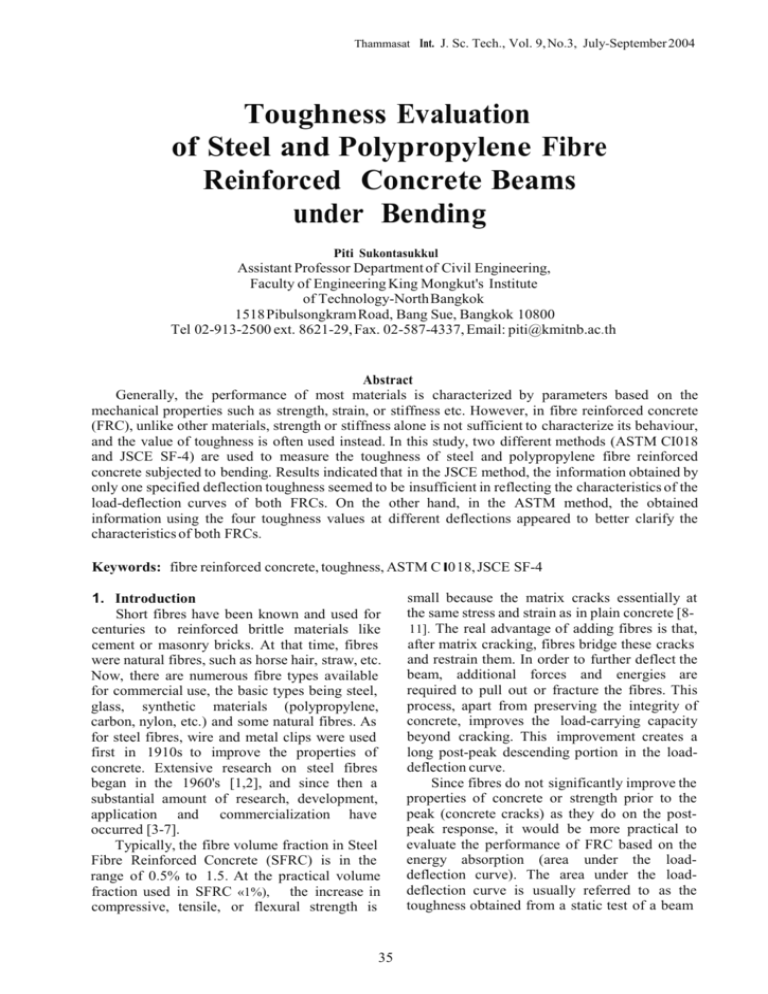Toughness Evaluation of Steel and Polypropylene Fibre Reinforced
advertisement

Thammasat Int. J. Sc. Tech., Vol. 9, No.3, July-September 2004 Toughness Evaluation of Steel and Polypropylene Fibre Reinforced Concrete Beams under Bending Piti Sukontasukkul Assistant Professor Department of Civil Engineering, Faculty of Engineering King Mongkut's Institute of Technology-North Bangkok 1518 Pibulsongkram Road, Bang Sue, Bangkok 10800 Tel 02-913-2500 ext. 8621-29, Fax. 02-587-4337, Email: piti@kmitnb.ac.th Abstract Generally, the performance of most materials is characterized by parameters based on the mechanical properties such as strength, strain, or stiffness etc. However, in fibre reinforced concrete (FRC), unlike other materials, strength or stiffness alone is not sufficient to characterize its behaviour, and the value of toughness is often used instead. In this study, two different methods (ASTM CI018 and JSCE SF-4) are used to measure the toughness of steel and polypropylene fibre reinforced concrete subjected to bending. Results indicated that in the JSCE method, the information obtained by only one specified deflection toughness seemed to be insufficient in reflecting the characteristics of the load-deflection curves of both FRCs. On the other hand, in the ASTM method, the obtained information using the four toughness values at different deflections appeared to better clarify the characteristics of both FRCs. Keywords: fibre reinforced concrete, toughness, ASTM C I0 18, JSCE SF-4 1. Introduction Short fibres have been known and used for centuries to reinforced brittle materials like cement or masonry bricks. At that time, fibres were natural fibres, such as horse hair, straw, etc. Now, there are numerous fibre types available for commercial use, the basic types being steel, glass, synthetic materials (polypropylene, carbon, nylon, etc.) and some natural fibres. As for steel fibres, wire and metal clips were used first in 1910s to improve the properties of concrete. Extensive research on steel fibres began in the 1960's [1,2], and since then a substantial amount of research, development, application and commercialization have occurred [3-7]. Typically, the fibre volume fraction in Steel Fibre Reinforced Concrete (SFRC) is in the range of 0.5% to 1.5. At the practical volume fraction used in SFRC «1%), the increase in compressive, tensile, or flexural strength is 35 small because the matrix cracks essentially at the same stress and strain as in plain concrete [811]. The real advantage of adding fibres is that, after matrix cracking, fibres bridge these cracks and restrain them. In order to further deflect the beam, additional forces and energies are required to pull out or fracture the fibres. This process, apart from preserving the integrity of concrete, improves the load-carrying capacity beyond cracking. This improvement creates a long post-peak descending portion in the loaddeflection curve. Since fibres do not significantly improve the properties of concrete or strength prior to the peak (concrete cracks) as they do on the postpeak response, it would be more practical to evaluate the performance of FRC based on the energy absorption (area under the loaddeflection curve). The area under the loaddeflection curve is usually referred to as the toughness obtained from a static test of a beam Tharnmasat Int. J. Sc.Tech.,Vol.9,No.3, July-September 2004 : fine : coarse) were cast in the form of beams (dimensions of 100 x 100 x 350 mm). Two types of fibres were used: Steel and Polypropylene at 2 different volume fractions: 1% and 2%. Geometrical details and properties of each fibre are given in Table I. The casting schedule is given in Table 2. After being removed from the molds, the specimens were then cured in water for 28 days before being subjected to test. All tests were carried out at the Department of Civil Engineering, King Mongkut's Institute of Technology-North Bangkok, using a 1500 kN universal testing machine. During the test, specimens were placed on a simple support with a clear span of 300 mm, and then subjected to a third-point loading at the rate 0.05 in/min (two point-loads at 1/3 of the clear span, Fig. 1). Results in terms of load-deflection curve were collected by a PC-based data acquisition system. specimen up to a specified deformation (not to be confused with the fracture toughness, Klc). The two most common methods to determine flexural toughness are based ASTM CIOl8 and JSCE SF-4 [12]. In ASTM C1018, toughness is specified in terms of toughness indices (Is 110 and ho), which refers to the area under the load-deflection curve calculated out to three different specified deflections. While, in the case of JSCE SF-4, the area under the loaddeflection curve up to a specified deflection (LlI50) is measured and referred to as the toughness. In this study, both ASTM and JSCE standards were used to determine the toughness of plain concrete as well as steel and polypropylene reinforced concrete beams. Results from both methods were then compared and discussed. 2. Experimental Program Plain and fibre reinforced concrete with the mix proportions of 1:0.45:1.7:2.7 (cement: water Table 1: Fibre Geometry Type Hooked End Crimped Material Shape ~ Steel Polypropylene ~ Length (mm) 60 58 Section Shape and Dimension (mm) Circle Rectangle Tensile Strength (MPa) Dia.0.50 1.0 x 0.5 1000 450 Table 2: Casting Schedule Concrete type Designation Plain concrete Steel FRC Steel FRC Polypropylene FRC Polypropylene FRC PLN lSFRC 2SFRC IPFRC 2PFRC Volume Fraction (%) No. of Sample - 5 5 5 5 5 1% 2% 1% 2% 36 Thammasat Int. J. Sc. Tech., Vol. 9, No.3, July-September 2004 LoadingHead E 4 • I I ~ L-~ o ID 38 ~ 5.58 I ~ 1050 Deflection Fig. 2: Fracture toughness and Indices according to ASTM CIOl8 Fig 1: Test Setup 3. Determining Fracture Toughness Two methods were used for determining the flexural toughness namely: ASTM CIOl8 and JSCE SF-4. In addition, the terms of toughness indices (Is, 110 and bo) are also calculated. Each index is the ratio between the post-peak toughness and the pre-peak (elastic) toughness (Fig. 2). 3.1 ASTM C1018 In ASTM CIOI8, toughness (or energy absorption defined as the area under the loaddeflection curve) is calculated out at 4 specified deflections (0, 30, S.So and 1O.SOF,ig. 2). The toughness is calculated at the deflection 0 which is considered the elastic or pre-peak toughness (first-crack toughness), while the other three (at 30, S.So and 1O.SOa)re considered the post-peak toughness. Is 110 Area OAB Area OACD = ho The residual strength represented by the average post-cracking load that the specimen may carry over a specific deflection interval are usually determined as follows: ' Rs,lo = 20(1,0 - 15) R10•20 =10(120 -110) Toughness corresponding to a deflection of 0, (To) = Toughness corresponding to 3.2 JSCE SF-4 Unlike the ASTM CIOI8, JSCE SF-4 provides just a single value of toughness. For a given load-deflection curve, toughness is the area under the load deflection curve measured up to a specified deflection, Otb = UlSO, as referred to Area OABC in Fig. 3. a deflection of 30, (T31i) Area OAEF = Area OAGH = Toughness corresponding to a deflection of 10.So (TlOso) where = The 0 Area OACDI Area OAB Area OAEF/Area OAB Area OAGHI Area OAB Toughness corresponding to a deflection ers.ss, (Tsso) The toughness factor (equivalent to the average residual strength) can also be determined as: deflection at the linear elastic limit Toughness factor = toughness x U(BH2 X Otb) where L B H Oth 37 Span length Width of the specimen = Height of the specimen = Deflection at LlI50 = = Thammasat Int. 1. Sc. Tech., Vol. 9, No.3, July-September 2004 In the case of polypropylene fibre reinforced concrete (PFRC) as shown in Fig. 5, the response found here was a typical 'double-peak' response. The first response was a typical response of concrete under bending. The load increased proportionally with the deflection up to the peak, and then the failure occurred due to the matrix cracking. The second response was the load recovery due to the effect of fibre bridging. A o Deflection 25.0 Fig. 3: Fracture toughness according to JSCE 20.0 i SF-4 ~ ~ 15.0 :g 4. Results and Discussion ...J ~ 10.0 ." 5.0 4.1 Load-Deflection Response ., ./ - Plain concrete"'l' 0.0 Typical load-deflection responses of plain concrete, SFRC and PFRC beams are given in Figs. 4 and 5. Comparing between plain concrete and FRC, it was the post-peak response that really differentiated the plain concrete from the FRC. For plain concrete, the behaviour was more in a brittle manner. Once the strain energy was high enough to cause the crack to self-propagate, fracture occurred almost instantaneously once the peak load was reached, due to the tremendous amount of energy being released. For FRC, the fibre bridging effect helped to control the rate of energy release. Thus, FRC maintained its ability to carry load after the peak. Comparing between each type of FRC, it could be seen clearly that the flexural responses of both FRCs were quite different. In the case of steel fibre reinforced concrete (FigA), the response was a so-called 'single-peak' response. Prior to the peak, the load increased proportionally with the increasing deflection, and then at the peak (concrete cracking), there was a slight drop of load before fibres began to take over and this led to a gradually drop of load. Unlike plain concrete where the point of concrete cracking indicated the point of failure, in FRC, with the effect of fibres bridging across the crack surface, FRC was able to maintain the load carrying ability even after the concrete had been cracked as shown in the descending long post peak response. I ~ISFRC / ~0.0 2.5 ._5.0 7.5 10.0 12.5 15.0 Deflection (mm) Fig. 4: Typical Load-Deflection Responses of Plain and Steel Fibre Reinforced Concrete 14.0 12.0 ~10.0 Z ::. B.O .s 6.0 4.0 2.0 - ,Plain concrete L 0.0 0.0 2.5 5.0 7.5 10.0 Deflection (mm) 12.5 15.0 Fig. 5: Typical Load-Deflection Responses of Plain and Polypropylene Fibre Reinforced Concrete The differences in the load-deflection responses of both fibres were essentially due to the properties of the fibres themselves. In SFRC, because of its high strength and stiffness, the fibres were highly effective in terms of bridging instantaneously over the cracks at a very small deformation or crack opening once the crack started to form. However, in the case of the polypropylene fibres which were low in strength and stiffness, they required much larger deformation or crack opening before the fibres could respond to the load. As a result of this, the 38 Thammasat Int. J. Sc. Tech., Vol. 9, No.3, July-September 2004 and this resulted in a large drop of strength in the load-deflection curve. Thus, the first peak response prior to the low recovery of PFRC got no action from the fibre and was, in fact, the response of the plain concrete. As for the steel fibre, the elastic toughness (T&) of SFRC changed and depended on the content of the fibre as seen by the increasing T& with the increasing fibre content. Because of the high strength and elastic modulus of steel fibre, immediately after the concrete first cracked, fibres started to take action. At low fibre content (1%), a small drop of load was found, and then followed by a quick recovery of load almost immediately. With the volume fraction of 2%, larger (twice) numbers of fibres were intercepted at the crack surface. This allowed fibres to pick up the load as soon as the concrete cracked, achieving no sign of strength drop. recovery of load was found late in the post-peak response ofPFRC (13). 4.2 Toughness In this section, toughnesses for both FRCs were measured according to the methods described before; the results are compared and discussed. 4.2.1 ASTM C101S According to this method, the toughness is measured at four different deflections: one prior to the peak (T&) and three after the peak (T 3&, Ts.s&and TIO.5&)(Table 3). Once obtained, they were then used to determine the toughness indices as shown in Table 3 and Fig. 6. Table 3: Toughness According to ASTM Concrete Type lPFRC 2PFRC lSFRC 2SFRC Toughness (N-m) 5.50 3d 8.3 16.3 27.2 11.2 24.2 12.9 28.4 55.5 0 2.7 2.6 2.3 3.5 ASTM Toughness VI CII 0 '6 .5 VI VI CII I: .::: CI ::::I 0 t- 10.50 30.7 65.4 49.9 92.6 Indices Consider the post-peak toughness (38, 5.58 and 10.58) by looking at the toughness indices, at small deflection (38 and 5.58), SFRC seemed to be tougher than PFRC at both volume fractions as indicated by the larger values of Is and 110. This was because, in PFRC, with a large drop of load immediately after the peak, the area under the curve (as well as toughness) of the PFRC became smaller than that of SFRC. However, at large deflection (10.58), once the polypropylene fibres in the PFRC came into play, the load started to recover and the toughness of the PFRC was found to be significantly increased, especially at 2% volume fractions where the toughness index of 2PFRC increased to almost the same level as that of 2SFRC. 30 25 20 15 10 5 1PFRC 2PFRC I_I, 1SFRC _II,. Toughness Indices 120 Is 110 6.1 11.6 3.1 4.2 24.7 10.3 10.4 21.3 5.5 8.2 15.9 26.6 2SFRC 1312. Fig. 6: Toughness Indices according to ASTM ClOl8 Consider the pre-peak (or elastic) toughness (T&).In the case of the polypropylene fibre, the pre-peak toughness (T&)of PFRC was found to be similar to that of plain concrete and remained constant even with the increasing fibre content from 1% to 2%. The reason for this performance was partly due to the material properties of the polypropylene fibre itself. With low strength and elastic modulus, after the first concrete crack, polypropylene did not take action immediately 4.2.2 JSCE SF-4 The toughness values and factor according to JSCE SF-4 of both FRCs are given in Table 4 and Fig. 7. 39 Thammasat Int. J. Sc. Tech., Vol. 9, No.3, July-September 2004 curve, rough descriptions of the behaviour of both FRCs could be achieved. For example, the small value of Is of the PFRC indicated that the PFRC did not perform well at the small deflection. However, the increase value of lzo of the PFRC to almost the same level as that of SFRC indicated that the performance of the PFRC was quite well at larger deformation. Table 4: Toughness according to ISCESF-4 Concrete Type IPFRC 2PFRC ISFRC 2SFRC Toughness (N-m) 8.3 9.8 18.5 30.8 Toughness Factor 1.24 1.47 2.78 4.62 5. Conclusions JSCE Toughness From this study, the conclusions drawn as follows: 35 30 E 25 ~ .. c .c t:II :> 0 I- 5.1 Both SFRC and PFRC behaved differently under bending. Due to the properties of the fibres, the behaviour of PFRC was clearly a double-peak response while the behaviour of the SFRC was a single-peak response. 5.2 Because of the way each FRC behaved differently, the toughness of each FRC was also different. 5.3 According to the ASTM method, with toughness measured out at 4 different deflections, the obtained information seemed to capture and reflect the true toughness properties of both SFRC and PFRC quite well. 5.4 On the other hand, the ISCE method, with a single value toughness, was not quite sufficient in reflecting the real toughness properties of the PFRC. 20 15 10 5 1PFRC 2PFRC 1SFRC can be 2SFRC Fig. 7: Toughness according to ISCE SF-4 Based on this method, for a given loaddeflection curve, a value of toughness measured up to a deflection ofLl150 (2 mm) is calculated and then used to determine the toughness factor. The obtained results indicated that the performance of SFRC is more superior than that of PFRC at both volume fractions. 4.2.3 ASTM CIOl8 vs. JSCE SF-4 Comparing between these two methods, single value toughness measured using the ISCE method did not have any difficulty reflecting the toughness property of the SFRC. However, in the case of PFRC, ISCE did not seem to be sufficient to reflect the true toughness property. For instance, if the toughness value provided by ISCE is considered alone without looking at the load-deflection curve, it will lead to the conclusion that the performance of PFRC was much poorer than that of SFRC which was not quite right. It is true that the toughness of PFRC at small deflection was poorer than that of SFRC, but, at the larger deflection, the performance of PFRC was increased to almost the same as that ofSFRC. On the other hand, the toughness provided by ASTM at different deflections seemed to work out well in term of capturing and reflecting the true toughness properties of both SFRC and PFRC. By considering the toughness indices alone without looking at the load-deflection 6. Acknowledgements The author would like to thank the SR Fibre, Co., Ltd. and the Bekeart Onesteel Fibre Australasia Co., Ltd. for providing both steel and polypropylene fibres. Special thanks are also due to the graduate students in the Advanced Concrete Technology course (185241) for their assistance. 7. References [1] Romualdi, J. P., and Batson, G. B, Mechanics of Crack Arrest in Concrete, Proceedings, ASCE, Vol. 89, pp. 147-168, EM 3, Jun 1963. [2] Romualdi, I. P., and Mandel, J. A., Tensile Strength of Concrete Affected by Uniformly Distributed Closely Spaced Short Lengths of Wire Reinforcement, ACI journal, Proceedings, Vol. 61, No.6, pp. 657-671 Jun 1964. 40 Thammasat Int. 1. Sc. Tech.,Vol. 9, No.3, July-Septembe2r004 [3] Shah, S., Concrete and Fibers Reinforced Concrete Subjected to Impact Loading, Cement-Based Composites: Strain Rate Effects on Fracture, Materials Research Society Symposia Proceedings Vol. 64, 1986. [4] Cottera1, B, Fracture Toughness and The Charpy V Notch Impact Tests, British Welding Journal, Vol. 9, No.2, pp. 83-90, 1962. [5] Manfore, G. E., A Review of Fiber Reinforcement of Portland Cement Paste, Mortar, and Concrete, Journal, PCA Research and Development Laboratories, Vol. 10, No.3, pp. 36-42, Sep 1968. [6] Shah, S. P., and Rangan, B. v., Fiber Reinforced Concrete Properties, ACI Journal, Proceedings, Vol. 68, No.2, pp. 126-135, Feb 1971. [7] Shah, S. P., and Rangan, B. V., Ductility of Concrete Reinforced with Stirrups, Fibers and Compression Reinforcement, Journal, Structural Division, ASCE, Vol. 96, No. ST6" pp. 1167-1185, Feb 1970. 41 [8] Johnston, C. D., Steel Fibre Reinforced Mortar and Concrete-A Review of Mechanical Properties, Fiber Reinforced Concrete, SP-44, American Concrete Institute, Detroit" pp. 124-142, 1974. [9] Williamson, G. R., The Effect of Steel Fibers on the Compressive Strength of Concrete, ACI Special Publication, SP-44: Fiber Reinforced Concrete, American Concrete Institute, Detroit, pp. 195-207, 1974. [10] Johnston, C. D., and Gray, R. 1., Uniaxial Tension Testing of Steel Fibre Reinforced Cementitious Composites, Proceedings, International Symposium on Testing and Test Methods of Fibre-Cement Composites, RILEM, Sheffield, pp. 451-461, Apr. 1978. [11] Mindess, S., Fibre Reinforced Concrete: Challenge and Prospects, Fiber Reinforced Concrete: Modem Development, pp. 1-12, 1995, [12] Mindess, S., Young, J. F., Darwin, D., Concrete 2nd Edition, Prentice hall, 2002.







